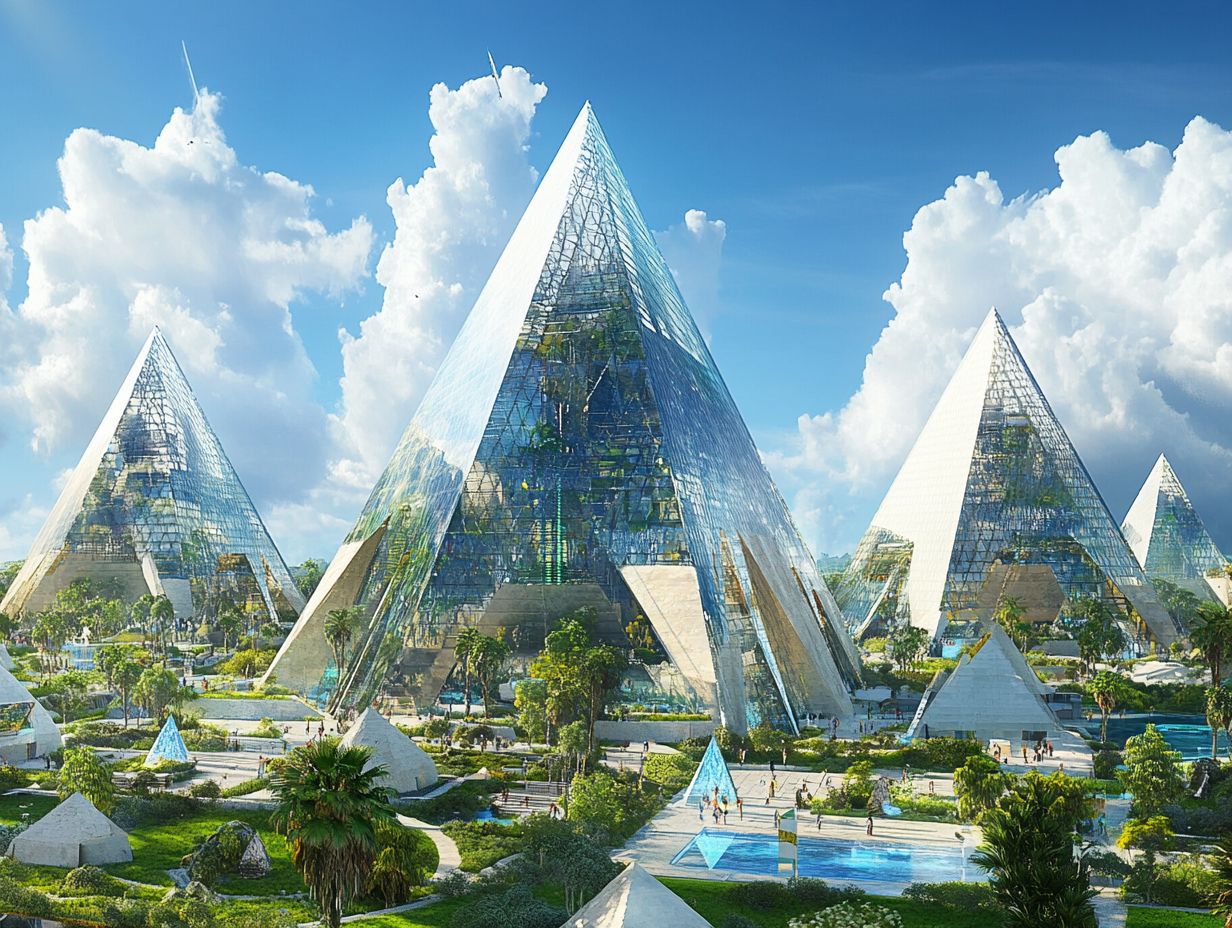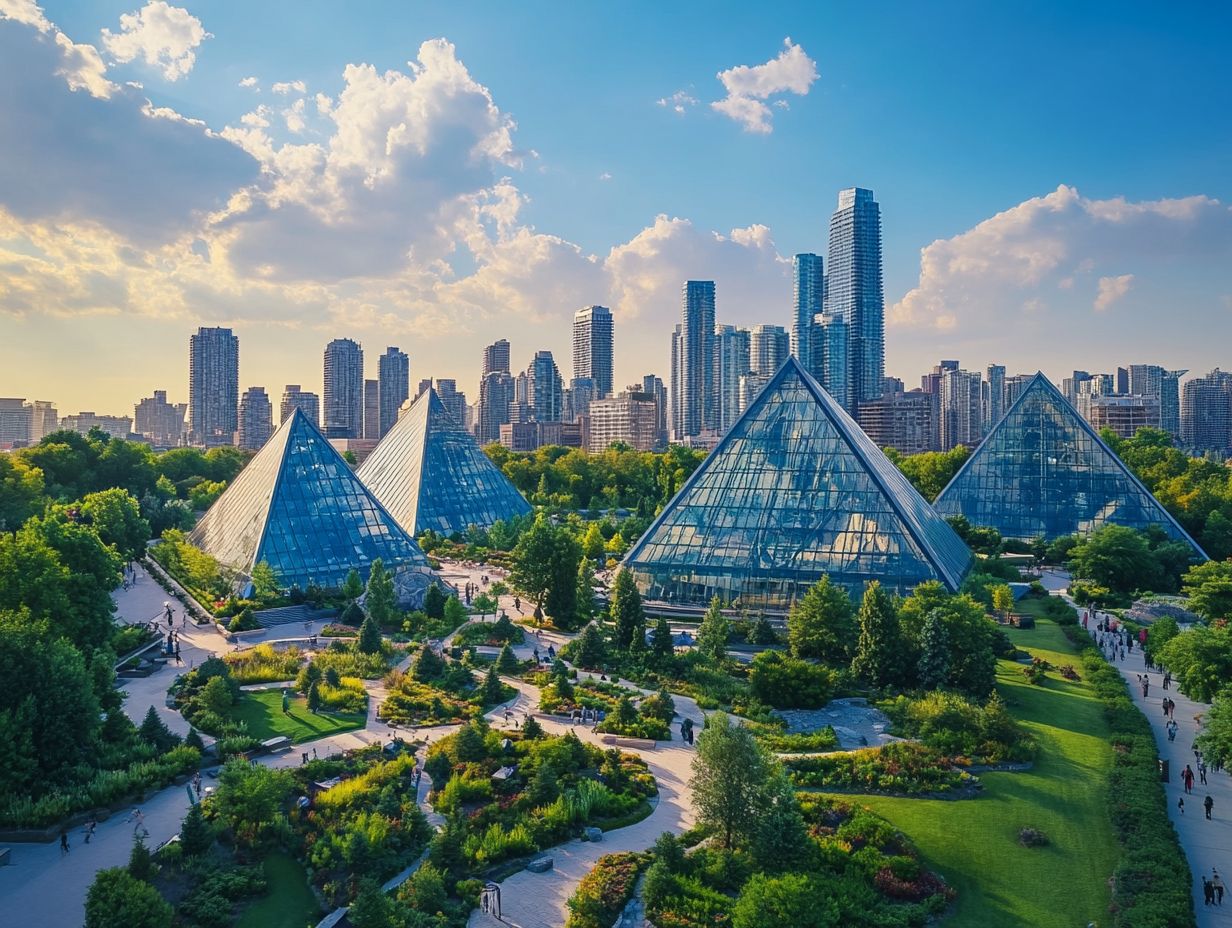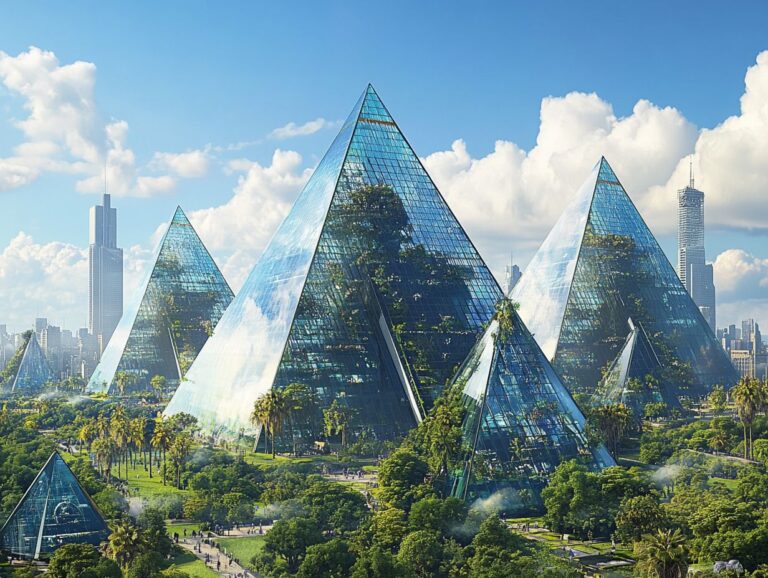Pyramid-inspired architecture is experiencing a remarkable resurgence in modern-day design, harmoniously blending ancient symbolism with contemporary innovation.
This exploration delves into the significance of pyramids within the realm of contemporary architecture, drawing inspiration from the majestic grandeur of ancient Egyptian edifices. From the iconic Rock and Roll Hall of Fame to the renowned Louvre Museum and the Memphis Pyramid, this piece highlights noteworthy pyramid-inspired structures and examines the design principles that render these buildings truly remarkable.
As it contemplates the challenges these architectural wonders encounter, it also casts an eye toward the sustainable trends that are poised to shape their future, including sustainable fashion within these multifunctional venues.
Key Takeaways:

Revolutionary Pyramid-Inspired Buildings Shaping Modern Architecture
Revolutionary pyramid-inspired buildings are making remarkable advancements in modern architecture, seamlessly merging ancient design principles with contemporary aesthetics. These monumental structures, often referred to as architectural landmarks, not only captivate the eye but also fulfill essential functions within urban landscapes.
From the iconic glass pyramid at the Louvre, masterfully designed by I.M. Pei, to the distinctive architectural elements of the Luxor in Las Vegas, these edifices embody a fusion of historical significance and innovative design.
Drawing inspiration from ancient Egypt and its architectural heritage, they contribute meaningfully to the evolving lexicon of modern architecture.
Significance of Pyramids in Modern Design
The significance of pyramids in modern design extends beyond mere aesthetics; these structures function as multifunctional venues that elegantly merge form and function, crafting architectural statements that resonate with both cultural heritage and innovative practices, while also standing as major attractions.
In urban environments, pyramids often emerge as focal points, attracting both locals and tourists alike, while providing spaces for recreation, education, and community gatherings. Their striking geometric forms can dramatically transform the skyline, introducing a sense of harmony amid the bustling chaos of city life, and their geometric similarities contribute to an architectural vocabulary that blends old and new.
The principles underpinning these structures reflect contemporary architectural values, emphasizing sustainability, versatility, and a profound connection to the surrounding environment. As urban planners and designers endeavor to create inclusive ecosystems, the pyramid shape stands out as a powerful symbol of progress, adeptly balancing the needs of the present with a visionary outlook for the future.
The Influence of Ancient Egyptian Architecture
The influence of ancient Egyptian architecture, particularly the iconic pyramids, is unmistakable in today’s architectural landscape, where modern designs frequently draw inspiration from the geometric precision and robust structures that have withstood the test of time, and have integrated features such as glass walls and open floor space.
These monumental edifices, celebrated for their meticulous craftsmanship and purposeful design, continue to inspire architects who seek to harmonize durability with aesthetic appeal. The interplay of light and shadow, a signature of ancient architectural styles, compels contemporary designers to prioritize natural lighting in their creations, often creating an optical illusion with their structures.
Elements such as grand columns, symmetrical layouts, and expansive open spaces reflect harmonious proportions, resonating profoundly with both structural integrity and visual allure.
By embracing these enduring principles, modern architects not only pay homage to the remarkable achievements of their predecessors but also create spaces that are both functional and evocative, effectively bridging the grandeur of the past with the aspirations of the future, through architectural design and innovative solutions.
Notable Pyramid-Inspired Buildings
Prominent pyramid-inspired structures across the globe showcase the remarkable versatility and allure of this architectural style. Among them, the Louvre Museum’s glass pyramid, conceived by the esteemed architect I.M. Pei, stands as a breathtaking entryway to a revered cultural institution, highlighting its historical significance.
Similarly, the Luxor in Las Vegas emerges as a monumental edifice, seamlessly blending entertainment with echoes of ancient inspiration.
Rock n’ Roll Hall of Fame / I.M. Pei
Designed by the illustrious architect I.M. Pei, the Rock n’ Roll Hall of Fame stands as a striking architectural statement, artfully merging the cultural significance of music history with innovative design principles that resonate within the realm of modern architecture. This architectural marvel is one of the key architectural landmarks in Cleveland.
Its captivating glass façade and geometric forms beckon visitors, inviting them to immerse themselves in the rich tapestry of rock music’s evolution. The design serves not only as a testament to Pei’s iconic style—characterized by transparency and light—but also underscores the Hall’s essential role as a communal space for both fans and musicians.
The structure’s interplay of angular and curved elements elegantly mirrors the dynamic essence of rock and roll, symbolizing its rebellious spirit while highlighting its profound influence on contemporary culture. Visitors often find themselves entranced by how the building’s aesthetics harmoniously align with its mission, celebrating the enduring impact of music as a transformative art form.
The Louvre Museum / I.M. Pei

The Louvre Museum’s glass pyramid, conceived by the renowned architect I.M. Pei, stands as a testament to architectural innovation, elegantly harmonizing the historical and modern elements of one of the world’s most esteemed cultural institutions.
This striking edifice has not only redefined the museum’s entrance, enhancing its visual allure, but it has also ignited vibrant discussions regarding the interplay between tradition and contemporary design in the heart of Paris. Its transparent structure permits natural light to cascade into the extensive underground space, cultivating a warm and inviting atmosphere for all who enter.
The pyramid’s significance transcends its bold geometric lines; it serves as a contemporary gathering place that elevates the typical museum experience. Visitors are encouraged to immerse themselves in both the art and the architectural marvel, forging a deeper connection to the treasures that lie within.
Nima Sand Museum / Shin Takamatsu
The Nima Sand Museum, envisioned by Shin Takamatsu, presents an innovative architectural design that embodies a unique lifestyle and interaction with its environment through its pyramid-inspired form.
This extraordinary museum not only celebrates the artistry of sand but also harmonizes with the natural landscape, utilizing materials and shapes that resonate with the surrounding dunes. The seamless integration of the structure into its setting underscores a commitment to sustainability, capturing both light and airflow to enhance the visitor experience. The museum is a prime example of how contemporary architecture can merge with environmental themes.
Positioned as a cultural hub, the museum brilliantly juxtaposes contemporary architectural principles with traditional elements, inviting observers to reflect on the delicate equilibrium between modern living and the timeless allure of sand. Such a meticulously crafted design encourages visitors to delve into and forge a profound connection with the landscape that envelops them, making it an architectural feature worth visiting.
Muttart Conservatory / Peter Hemingway
The Muttart Conservatory, conceived by the visionary architect Peter Hemingway, stands as a remarkable botanical conservatory characterized by its elegant pyramid shapes. This striking design offers a unique perspective on the presentation of plant life, seamlessly integrating nature with architectural artistry. For more on the influence of pyramid-inspired designs, check out this Revolutionary Pyramid-Inspired Buildings Shaping Modern Architecture.
“`html
The Muttart Conservatory, conceived by the visionary architect Peter Hemingway, stands as a remarkable botanical conservatory characterized by its elegant pyramid shapes. This striking design offers a unique perspective on the presentation of plant life, seamlessly integrating nature with architectural artistry. For more on the influence of pyramid-inspired designs, check out this Revolutionary Pyramid-Inspired Buildings Shaping Modern Architecture.
“`
The impressive glass pyramids not only captivate the eye but also foster diverse microclimates, nurturing a vast array of plants sourced from various global regions. These complex structures showcase how contemporary architecture can host robust olfactory systems. Visitors are invited to explore four themed biomes, each meticulously designed to emulate its specific environment, ranging from arid deserts to verdant tropical rainforests.
The masterful play of natural light filtering through the glass enhances the sensory experience, allowing guests to fully engage with a vibrant and tranquil landscape that beautifully contrasts with the urban surroundings. This unique architectural process and its botanical integration make the Muttart Conservatory a standout in Edmonton.
Palace of Peace & Reconciliation / Norman Foster
The Palace of Peace and Reconciliation, masterfully designed by Norman Foster, presents an architectural marvel that embodies multifunctionality through its striking pyramid form. This iconic structure serves as a focal point for cultural events and gatherings in Astana, bridging historical buildings with modern-day architectural solutions.
Standing as a testament to modern urban architecture, the Palace of Peace and Reconciliation seamlessly marries innovative design with practical functionality. Its glass and steel façade not only amplifies its visual allure but also invites an abundance of natural daylight into its interior spaces. The unique triangular layout fosters a vibrant environment, accommodating a diverse array of activities, from concerts and forums to exhibitions and conferences.
Symbolizing harmony and unity, the Palace reflects the aspirations of a multi-ethnic society, serving as a beacon of hope for future generations. This remarkable blend of historical significance and architectural design positions it as an integral component of the city’s cultural landscape.
Design Principles and Innovations
The design principles and innovations inherent in pyramid architecture exemplify a harmonious blend of structural engineering and aesthetic considerations. This geometric form not only adapts to contemporary environmental themes but also offers innovative design solutions to complex architectural challenges.
Structural Innovations in Pyramid Design
Structural innovations in pyramid design have paved the way for complex structures that challenge traditional architectural methods and redefine the potential of pyramid shapes in contemporary construction. These advancements not only enhance the aesthetic appeal of such structures but also improve their sustainability and functionality.
Notable examples include the Ziggurat of Ur in Iraq, the Louvre Pyramid designed by I.M. Pei in Paris, and the Luxor Las Vegas, where modern materials and computational design techniques have enabled the creation of iconic forms that serve practical purposes.
“`html
In recent projects, engineers have embraced 3D printing and modular construction, facilitating rapid assembly and customization—demonstrating the revolutionary impact of technology on pyramid architecture, including revolutionary pyramid-inspired buildings shaping modern architecture, such as the Memphis Pyramid and the Great Sphinx of Giza.
“`
As the exploration of these innovations continues, the future of pyramid designs appears increasingly promising.
Symbolism in Architecture

The pyramid shape embodies profound symbolism in architecture, representing stability and strength while simultaneously serving as an artistic reflection of cultural values and beliefs in contemporary designs.
This geometric form has transcended the ages, evolving from its sacred associations in ancient Egypt to its innovative applications in modern structures. Today, architects integrate pyramidal elements into their creations, not merely for aesthetic allure but also to instill a sense of balance and order.
The open floor space and abundant natural daylight often present within these edifices further amplify their symbolic significance, engaging occupants on a deeper emotional plane. As modern architecture continually draws inspiration from historical motifs, the pyramid persists as a potent symbol, seamlessly melding tradition with forward-thinking design.
Challenges and Critiques
Despite their innovative allure and visually powerful presence, pyramid-inspired buildings encounter a range of challenges and critiques. These include contemporary objections regarding their aesthetic appeal, as well as environmental and practical considerations that affect their functionality and integration within the urban landscape.
Contemporary Criticism of Pyramid Structures
Contemporary critiques of pyramid structures often center on their visual impact and their integration within the architectural tapestry of surrounding urban environments, provoking inquiries into their relevance in modern architecture.
These criticisms frequently underscore concerns regarding the stark contrasts between the sleek, angular lines of pyramid shapes and the more organic forms that typically characterize contemporary cityscapes. Detractors contend that such structures can disrupt the established aesthetic of neighborhoods, interrupting the flow and coherence of the urban fabric.
Discussions within architectural discourse stress the importance of buildings engaging meaningfully with their surroundings, advocating for designs that honor historical contexts while simultaneously enhancing community experiences. Striking a balance between innovation and harmony remains a vital objective for architects contemplating the incorporation of pyramidal forms in densely populated areas.
Architectural landmarks like the Louvre Museum and Great Sphinx of Giza exemplify the integration of historical significance with modern architectural vocabulary.
Environmental and Practical Considerations
Environmental and practical considerations are pivotal in the design of pyramid structures, as architects endeavor to achieve a harmonious balance between sustainability and functionality, particularly in their choices of materials and energy efficiency.
These considerations necessitate a comprehensive exploration of how various design elements and innovations can enhance ecological integrity while meeting practical requirements. Designers are increasingly favoring local and recycled materials, thereby minimizing transportation-related emissions and reducing waste.
The integration of renewable energy sources—such as solar panels or wind turbines—into the structure not only mitigates the carbon footprint but also promotes self-sufficiency.
Moreover, innovative strategies such as rainwater harvesting systems and green roofing further bolster the environmental resilience of pyramid designs, ensuring they seamlessly blend with their surroundings while effectively addressing urgent contemporary challenges. Architectural features like those seen in the Muttart Conservatory and Sunway Pyramid Shopping Mall illustrate practical applications of these concepts.
The Future of Pyramid-Inspired Architecture
The future of pyramid-inspired architecture stands on the brink of exhilarating advancements, as emerging trends increasingly prioritize sustainability and architectural innovation.
This evolution is set to cultivate vibrant community spaces that seamlessly integrate both aesthetic appeal and practicality, creating a unique lifestyle and architectural statement.
Trends and Sustainability
Emerging trends in pyramid architecture prioritize sustainability, seamlessly integrating environmental themes into design processes. This results in structures that not only captivate the eye but also significantly reduce their ecological footprint.
Such an approach enhances the aesthetic appeal of these edifices while aligning with contemporary demands for energy efficiency and resource conservation. Architects are increasingly venturing into the realm of innovative materials that diminish carbon emissions. They are also incorporating renewable energy sources, such as solar panels, into their designs. The emphasis on biophilic design elements fosters a profound connection between occupants and their surroundings, ultimately promoting well-being.
As these practices gain traction, they pave the way for architectural solutions that honor the planet, ensuring that future developments strike a harmonious balance between ambitious design and environmental stewardship.
Impact and Legacy of Pyramid-Inspired Buildings

The impact and legacy of pyramid-inspired buildings resonate profoundly within the architectural community, illustrating how these unique structures continue to shape modern design and cultural narratives.
These geometric marvels serve not merely as symbols of stability and balance; they also encapsulate the aspirations of societies that strive to reach for the heavens. Their influence is evident in various forms, ranging from iconic landmarks to subtle design elements woven into contemporary architecture. The interplay of light and shadow within these shapes often ignites emotional connections, affecting how individuals engage with their environments. Architectural solutions seen in the Slovak Radio Building and the Walter Pyramid highlight their contribution to urban landscapes.
As architects and designers gaze toward the future, the potential for incorporating pyramid shapes into sustainable living spaces and public architecture promises to unlock new avenues for innovation. The enduring significance of these forms hints at a cultural dialogue that fosters both a rich historical appreciation and a forward-thinking creativity.
Frequently Asked Questions
What are some examples of revolutionary pyramid-inspired buildings shaping modern architecture?
Some prominent examples include the Louvre Pyramid in Paris, the Luxor Hotel in Las Vegas, the Memphis Pyramid, and the Transamerica Pyramid in San Francisco.
What makes pyramid-shaped buildings stand out in modern architecture?
The unique shape and structure of pyramid-inspired buildings offer a striking visual impact and a sense of grandeur, making them stand out in the modern architectural landscape. They often serve as monumental structures and major attractions, embodying artistic expression.
What are the functional benefits of incorporating pyramid shapes in building design?
Pyramid-inspired buildings often have spacious interiors with high ceilings, allowing for natural light and ventilation. They are also structurally stable and can withstand strong winds and earthquakes. This architectural process creates multifunctional venues that enhance community experiences.
How do pyramid-shaped buildings contribute to sustainable architecture?
The sloping sides of pyramid-shaped buildings can be used for green roofs, solar panels, and rainwater harvesting systems, making them more environmentally friendly and energy-efficient. These buildings often include biophilic design elements that promote well-being and resource conservation.
What challenges do architects face when designing pyramid-inspired buildings?
The complex geometry of a pyramid can present challenges in terms of structural stability and construction methods, often requiring innovative design and structural engineering solutions. Architects also have to carefully consider the functionality and usability of the interior spaces, ensuring they accommodate modern-day needs and incorporate architectural features such as glass walls and open floor space for natural daylight.
Is the use of pyramid shapes in modern architecture a passing trend or a lasting influence?
While some may see it as a passing trend, the use of pyramid shapes in modern architecture has been around for centuries. Iconic examples include the Louvre’s glass pyramid designed by I.M. Pei and the Luxor Hotel in Las Vegas. These structures continue to inspire and influence architects today, making it a lasting trend in the industry. They serve as major attractions and architectural landmarks, reflecting both historical significance and contemporary architectural vocabulary.





